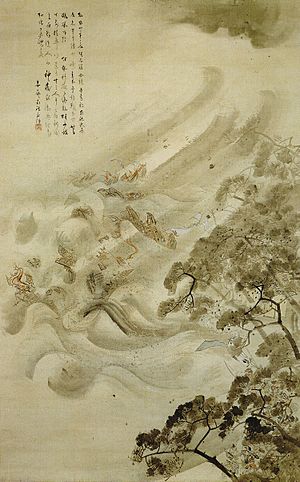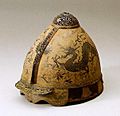Mongol invasions of Japan facts for kids

Mongol invasions of Japan (元寇, Genkō) in 1274 and in 1281 were major military events in Japanese history. Kublai Khan twice tried to conquer the Japanese islands; and his armies failed both times.
The two failed invasion attempts are important because they were defining events in Japanese history.
The attempts show the limits of Mongol (Yuan Dynasty) ability to expand the Chinese empire.
Timeline
- November 19, 1274 (Bun'ei 11, 20th day of the 10th month): Kublai Khan sent a fleet and an army to invade Japan. Some military forces landed near Fukuoka in Kyūshū; however, a storm sank many of the ships. The major part of the invading army is drowned. The invaders retreat to Korea. During the brief fighting, the Hakozaki Shrine was burned to the ground. This is called the Battle of Bun'ei (文永の役, Bun'ei no eki) or the "Bun'ei War".
- 1281 (Kōan 4): There was a second Mongolian attempt to invade Japan. This is called the Battle of Kōan (弘安の役, Kōan no eki) or the "Kōan War".
Consequences
After the destruction of the Mongol invaders, Japan's independence was guaranteed. A power struggle within Japan led to the growth of military governments and less Imperial power.
Related pages
- Fukuoka/Hakata Tourist Information, "Historic spots of Genko (Mongol invasion of Japan)"
- Bowdoin, Mongol Invasions of Japan
Images for kids
-
Letter from Kublai Khan of the "Great Mongol State" (大蒙古國) to the "King of Japan" (日本國王), written in Classical Chinese, the lingua franca in East Asia at the time, dated 8th Month, 1266. Now stored in Tōdai-ji, Nara, Japan.
-
Japanese samurai boarding Yuan ships in 1281.
-
A typical Ko-Hōki (old Hōki) school tachi. Dōjikiri, by Yasutsuna. 12th century, Heian period, National Treasure, Tokyo National Museum. This sword is one of the Five Swords Under Heaven. (天下五剣 Tenka Goken)
-
A Sōshū school katana. It was originally a tachi forged by Masamune in the 14th century, but later it was cut from the root and converted into a katana. As it was owned by Ishida Mitsunari, it was commonly called Ishida Masamune. Important Cultural Property, Tokyo National Museum.
See also
 In Spanish: Invasiones mongolas de Japón para niños
In Spanish: Invasiones mongolas de Japón para niños














